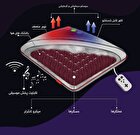Iranian Researchers Produce Borophene as Substitute for Graphene in Electronic Industry

In an interview with local Iranian media, Alireza Eskandari, one of the researchers of a project to produce the graphene-like material, stated that, “The product we produced in this project is a two-dimensional material called ‘Borophene’, which is considered as a serious and new competitor for graphene.”
He described Borophene as a monolayer of boron, which has risen as a new exciting two-dimensional (2D) material having extraordinary properties.
“Two-dimensional material needs substrates to be mounted on it, and this material is such that it can be mounted on any substrate and ground,” he said.
“The innovation of our work is the method of synthesizing and manufacturing the Borophene material, which is called the CVD or Chemical Vapor Deposition method. With this method, we were able to produce Borophene in large formats,” he added.
“One of the challenges of two-dimensional materials is that they cannot be synthesized in large formats, but with the efforts done by the researchers of this company, we were able to produce this material in large dimensions.”
He said another innovation of their product in the knowledge-based company to be the software that was created for it, explaining that, “We tested Borophene on supercapacitors, sensors, and catalysts, and we obtained good and favorable results in all 3 of these cases.”
“The main use of two-dimensional materials is that they can improve the performance of a system. For example, if we have an optical sensor with a certain level of sensitivity, by using the Borophene material, its sensitivity is significantly improved, and in supercapacitors, it also increases their charge and discharge,” Eskandari further explained.
Stating that this two-dimensional material has a nano-structure, the researcher concluded, “The most important application of this material is in the electronic industry, but it is also utilized in other industries.”
4155/i





















